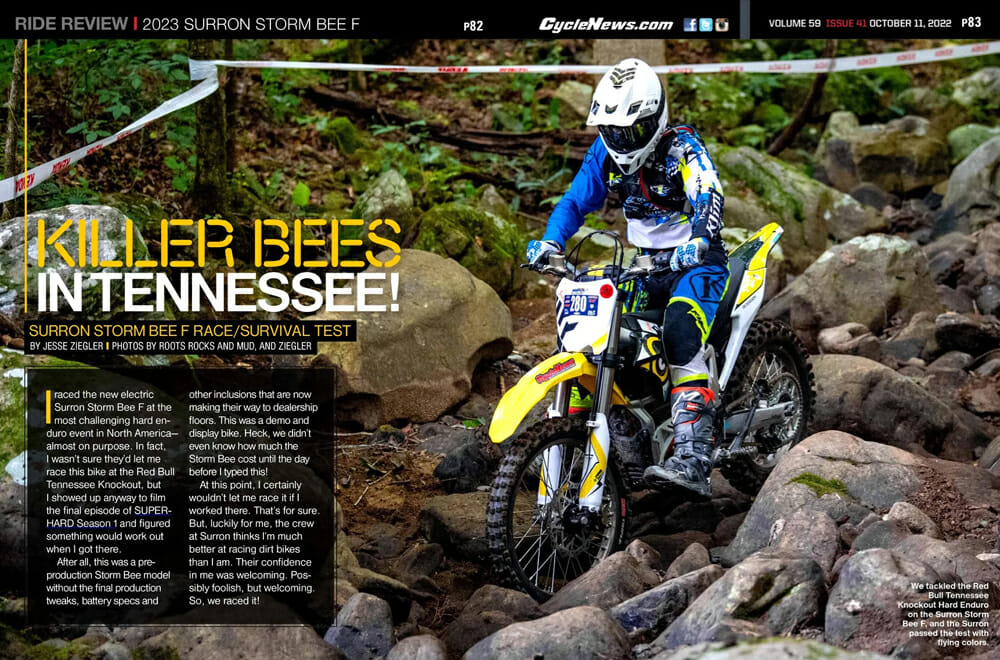Jesse Ziegler | October 13, 2022
I raced the new electric Surron Storm Bee F at the most challenging hard enduro event in North America—almost on purpose. In fact, I wasn’t sure they’d let me race this bike at the Red Bull Tennessee Knockout, but I showed up anyway to film the final episode of SUPERHARD Season 1 and figured something would work out when I got there.
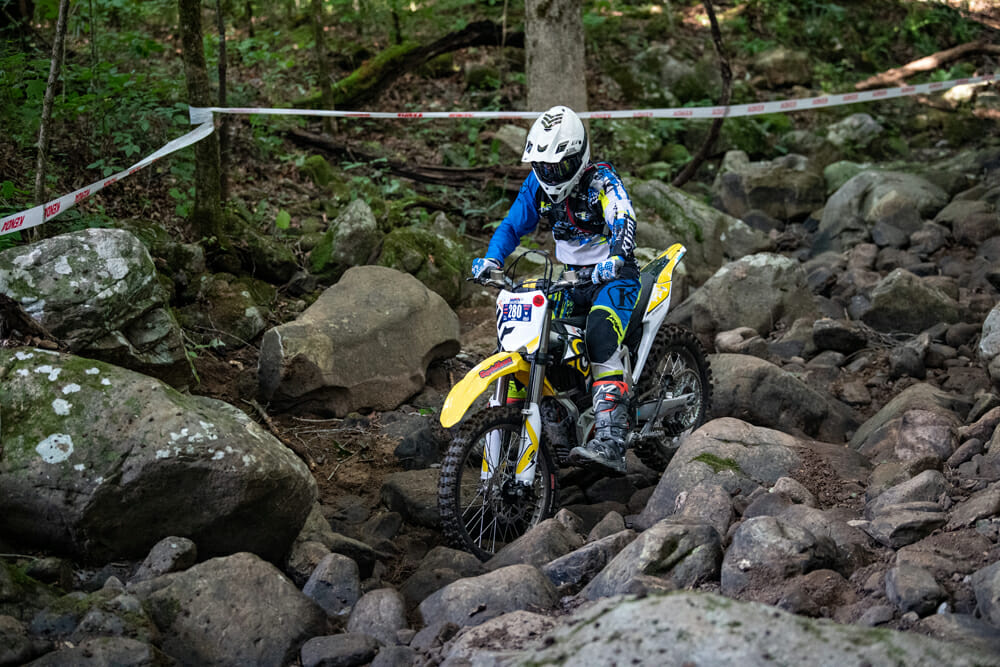 We tackled the Red Bull Tennessee Knockout Hard Enduro on the Surron Storm Bee F, and the Surron passed the test with flying colors.
We tackled the Red Bull Tennessee Knockout Hard Enduro on the Surron Storm Bee F, and the Surron passed the test with flying colors.
Photos by Roots Rocks and Mud, and Ziegler
After all, this was a pre-production Storm Bee model without the final production tweaks, battery specs and other inclusions that are now making their way to dealership floors. This was a demo and display bike. Heck, we didn’t even know how much the Storm Bee cost until the day before I typed this!
At this point, I certainly wouldn’t let me race it if I worked there. That’s for sure. But, luckily for me, the crew at Surron thinks I’m much better at racing dirt bikes than I am. Their confidence in me was welcoming. Possibly foolish, but welcoming. So, we raced it!
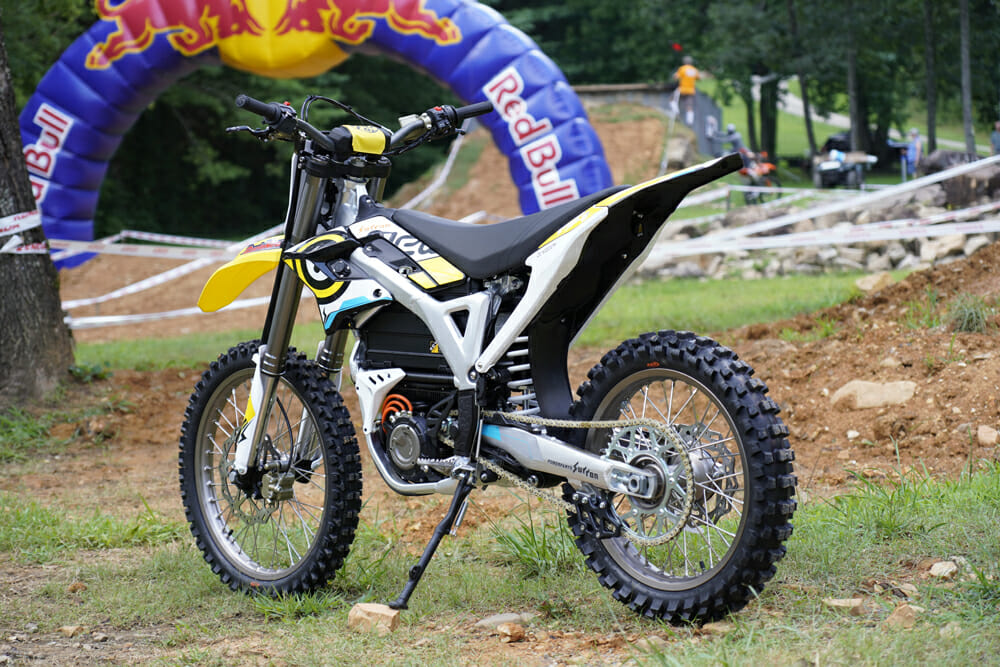 With an $8499 starting price, both the price and its looks are attractive.
With an $8499 starting price, both the price and its looks are attractive.
2023 Surron Storm Bee F Review | What is a Surron?
You probably know what a Surron is, even if you don’t know it yet. You’ve likely seen their spirited Light Bee model ripping around your hometown’s dirt lots, looking for jumps to hit or parking lots to roost and girls to impress via the teenage population on-board. That platform has been in the world since 2018 and we even tested the Surron Light Bee X.
It’s the sort of bike that builds a movement of underground hooliganism. Kids want it. Adults giggle when they ride it. People are modifying them like mad to race regularly. Nobody knows if they should wear full moto gear or skate helmets and Vans when they ride it at first. It’s a sort-of goofy, incredibly fun, motorcycle thing that is free of category definitions. It’s fresh.
Up to now, that was a Surron. It wasn’t a Light Bee, it was a Surron. With the introduction of the Storm Bee F—an enduro dirt bike by all classification—all has changed. Now, Surron is the brand tip of the spear and models are branching down below. Remember these names, you’ll keep hearing about them.
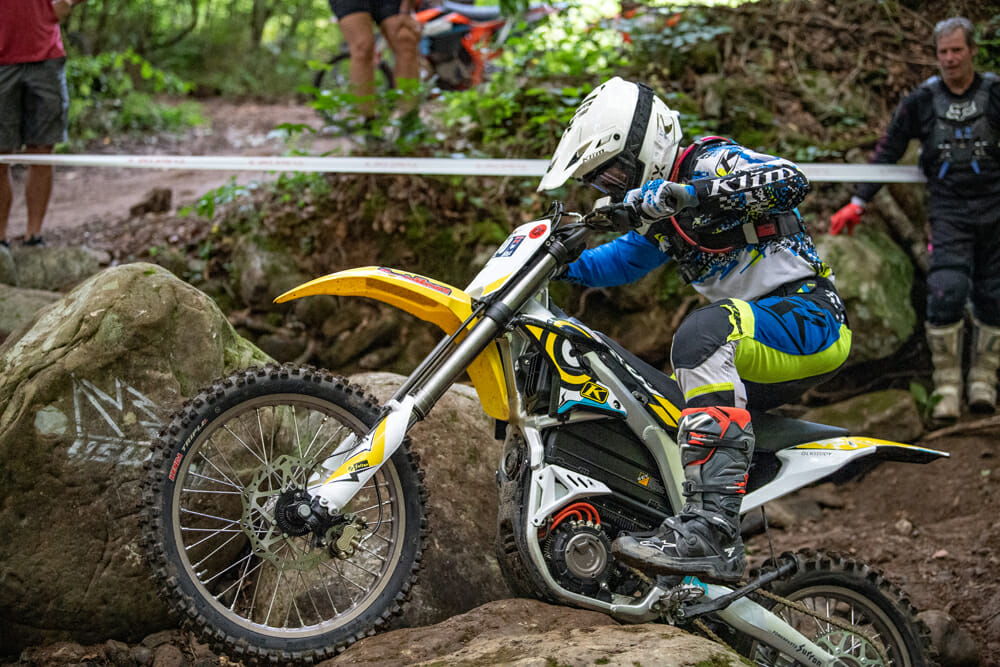 At a claimed 290 pounds, the Storm Bee F isn’t light.
At a claimed 290 pounds, the Storm Bee F isn’t light.
The Storm Bee is 100-percent dirt bike. It isn’t a play bike like its smaller sibling. It has real dirt bike-scaled componentry and power. It has the girth and heft of a grown-up’s motorcycle with wheels, tires, footpegs, handlebar, controls and performance to match. It is, without a doubt, a real motorcycle. It will not avoid attention from the neighborhood Homeowners Association very well.
For North America, the Storm Bee F comes as an off-road-only model (no 50-state street legality) and comes with both the headlight and a blank front number plate for $8499.
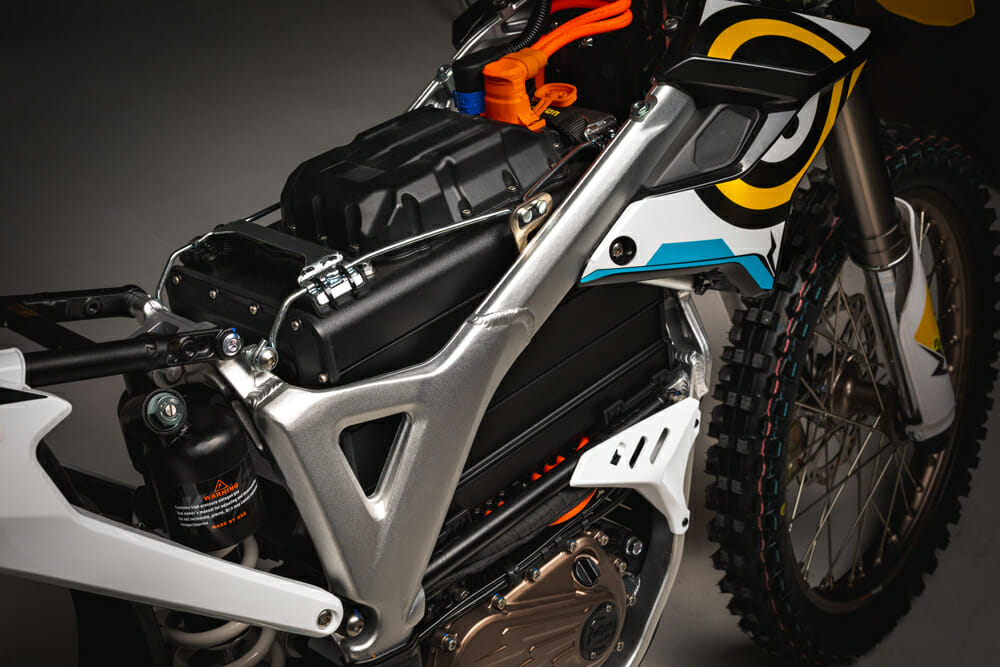 The Storm Bee F should have enough juice to get you through a hard enduro race like the amateur portion of the Red Bull Tennessee Knockout.
The Storm Bee F should have enough juice to get you through a hard enduro race like the amateur portion of the Red Bull Tennessee Knockout.
2023 Surron Storm Bee F Review | Killer Bees!?
Building a full-size enduro bike in today’s world takes guts. The ones already here are so damn good! Building an electric one? That is a bold step. I’ve seen plenty of e-bike startups come, promise and under-deliver, as they try to compete with the massively efficient and capable crop of current new and used gas-powered machines in the market. They usually come into the market over-hyped, over-priced and quickly running out of range to really make it in the real world as a replacement machine.
Can the Surron Storm Bee F shift that trend? That depends on what it’s truly trying to be here.
First, Surron is skipping a big part of the electric-bike hype here in that they never claim to out-perform any of the industry standards. That’s smart as this is the first full-size motorcycle they’ve built. Surron isn’t trying to replace GNCC racing 250s, 350s and 450s just yet. What they’re doing is dropping a full-size enduro bike, with adequate performance specs and components, into the market at a competitive new-bike price.
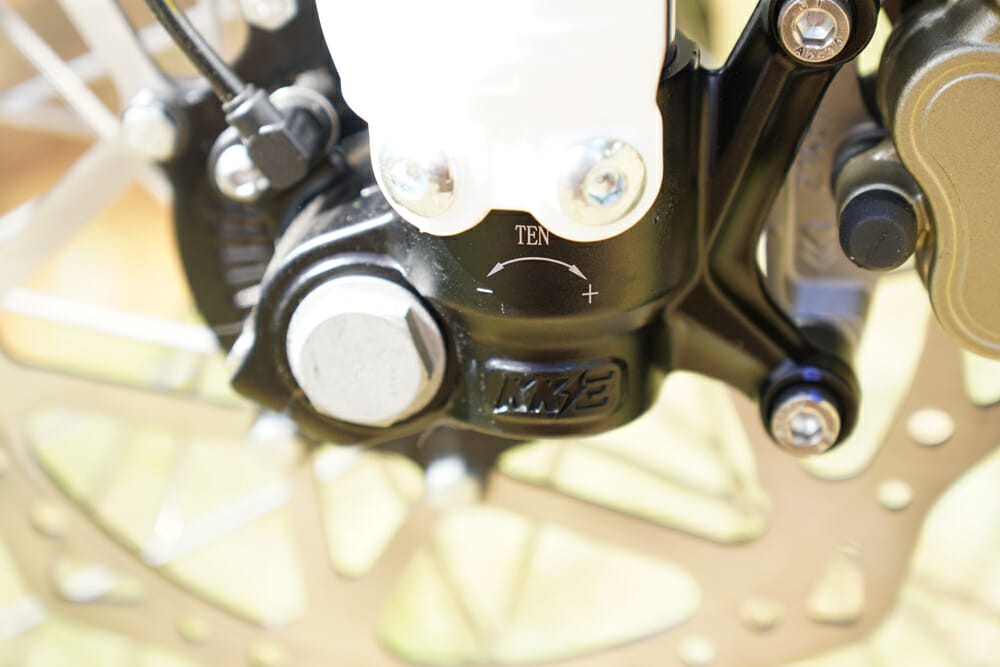 Careful not to round off the front axle nut. It’s easy to do.
Careful not to round off the front axle nut. It’s easy to do.
Performance specs are capable at 22.5 kW of peak power (about 30 horsepower) jolting out of the liquid-cooled brushless electric motor and put it in line with enduro stalwarts like the Honda CRF250X and the Yamaha WR250F, for example.
The Surron stands out with electric motor torque numbers that pump out an eye-popping 520 nM, or 383 lb-ft of torque. The bike claims a 68-mph top speed and zero-to-31 (50km/h) in 1.8 seconds. Thanks torque!
Right at official launch, Surron upped the ante on the battery boldness with an increase of 14V from 90V on the bike I raced to 104V on the production unit. That voltage increase will bump up range and top speed a little. If I had to guess, this bike will likely see rolling improvements like this year over year.
The real differentiating factor from gas-powered performance are ride modes and electronic aids. This bike has three ride modes and a Turbo Button. Yes, Turbo Button that unleashes all electronic fury for 10 seconds. It also has reverse and traction control. Yep, reverse. The TC can be turned on and off on the fly and ride modes (Eco, Rain, Sport) inject different power delivery and engine resistance/braking into the mix.
Really, this puts the Storm Bee right into the recreational off-road/enduro market with electrical flair and the convenience of an electric machine. Saturday trail rides with the family, after-work laps around a turn-track on your property, and other casual off-road uses are really what it was built for.
The biggest question here and with all battery-operated machines, is range/runtime. And Surron claims you can ride about 75 miles at 31 mph on a full charge, depending on terrain and throttle-happiness. This is the vagueness that haunts electric bike buyers and converters. But 75 miles at a casual pace is a pretty good upward limit. Let’s see how that turns out.
Surron doesn’t drop in name-brand suspension or brake components here. Fastace is listed as the suspension supplier and the 47mm fork felt surprisingly good. Full travel front and rear is rated at 11.4 inches (290mm) and each end is fully adjustable. Likewise, the unbranded brakes did some stopping. Granted, I’m going pretty slow at TKO.
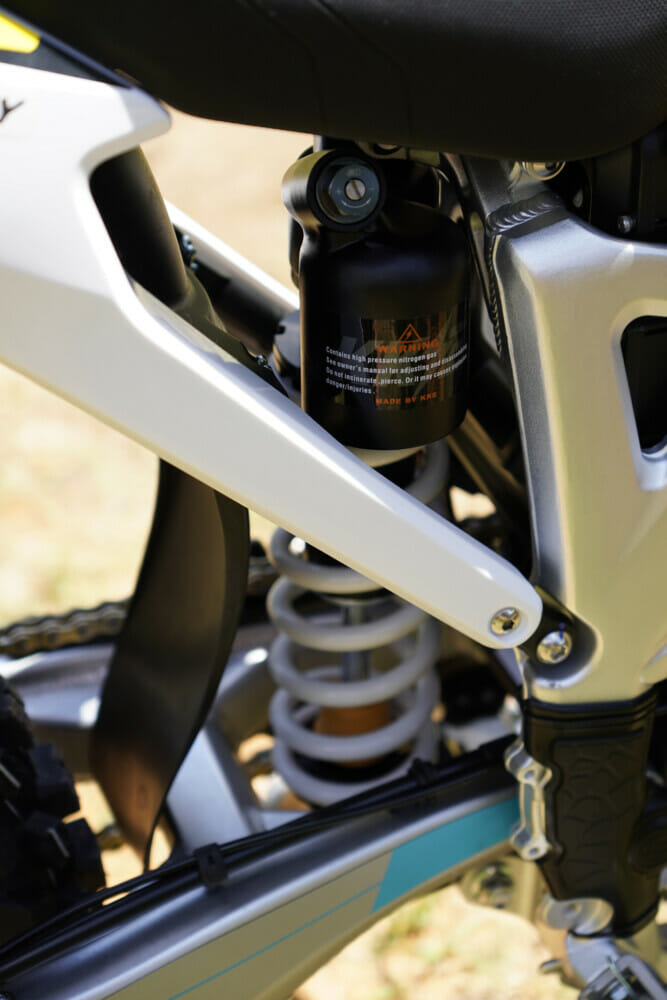 You won’t see name-brand suspension components on the Surron, but the Fastace shock and fork are surprisingly sufficient.
You won’t see name-brand suspension components on the Surron, but the Fastace shock and fork are surprisingly sufficient.
2023 Surron Storm Bee F Review | So… You Raced It!?
Nothing like being thrown out of the hive as a little worker bee and fighting for survival, am I right? Yes, I took the opportunity to not only test a pre-production Storm Bee F, which is arguably not a race bike, but I raced it at the biggest hard enduro event in America.
This was the first year of the Electric Cycle Rider EMoto class at TKO—a field full of Surron Light Bees, Electric Motion uber-expensive trials machines and some one-off handmade dirt bike weapons. And me. On a Storm Bee. Just wingin’ it.
TKO is a great event for this test. There is a one-lap time trial for your starting position into the ECR EMoto main event. You race that for a couple hours. Then, if you do well enough in that race (cut-off time was 1:45 or so) you can (it’s optional) take your electric motorcycle into the amateur main event in the afternoon and annoy gas bike riders.
Generally, the races get longer and harder the more you race at TKO. And you have time between each to evaluate, adjust and get motivated to try again.
VIDEO | 2023 Surron Storm Bee F Race Test
I rode all three events, putting in a decent time in the hot lap, limping in a low-voltage/dying battery condition in the EMoto main to qualify for the Amateur main (we didn’t start with a full battery—oops!) and eventually bailing about halfway through the Amateur main due to complete and total exhaustion on my part.
It’s clear the Surron can compete for two hours or so on a closed course like this. I’m sure total range will vary on production bikes and, really, just how fast you’re going. Remember hard enduro is notoriously slow. That’s truer when I do it. With a full battery and a couple races on my shoulders, I wore out before the Storm Bee did in the final event of the day.
As the battery drops, a life indication on the dashboard tells you what’s going down. As we dropped under 30 percent, I switched modes to proactively engage more engine regeneration and/or mellow out the output to conserve power. I really don’t think regeneration (engine braking) will make a huge difference on a slow course like this. And it probably didn’t. Also, I’m “racing.” So, just seeing “Eco” mode on the dashboard was a little odd.
To me, all this race-test range business translates to a trail machine range suitable for shorter days and smaller loops from a home base. You could probably get the 75 miles claimed if you went 25-30 mph on smoother trails. But this electric machine is still going to fall short by miles compared to a few gallons of gas on a basic trail bike.
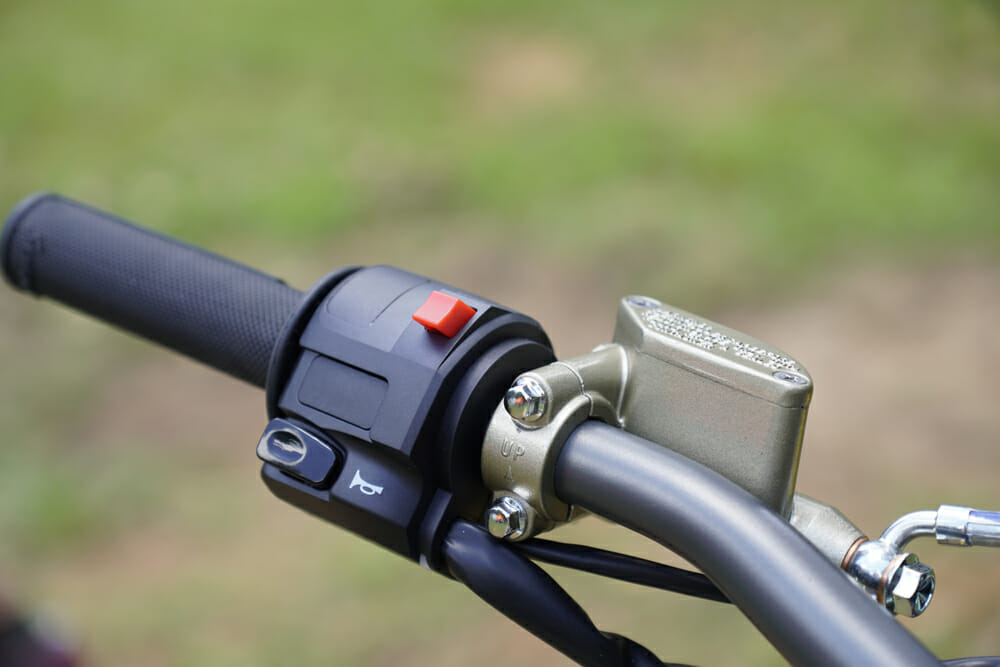 Look mom, no clutch! That’s the rear brake up front on the left grip. Oh, and a Turbo Button!
Look mom, no clutch! That’s the rear brake up front on the left grip. Oh, and a Turbo Button!
Charging the bike is simple via a 110V charger (included in the price of the bike) that claims to fill the battery from dead to full in four hours or less.
Before the race I did the bare minimum of hard enduro race preparation (sort of on-brand for me). I adjusted the bars/levers, ripped around a few fields to get the feel for the bike, swapped the stock front tire for a Kenda Triple and found a take-off IRC gummy rear tire next to a friend’s trailer (thanks, Joe!). I stuck with tubes, because mousses were hard to find on short-notice and just dropped the psi to dangerously flat-prone levels. Hard enduro is about traction, after all.
During my tweaking I noticed some high-quality build features and fasteners, and some sort of strange ones you wouldn’t see on a Japanese or European enduro weapon. The strangest fastener was the rear axle nut/spacer area. The nut is almost recessed into the axle block, so it was a challenge to loosen and tighten without fear of stripping the outside of the nut. The wheels felt heavy and sort of cheap when I swapped tires. But nothing broke on this bike during my abuse.
In use, the bike has some massive advantages on a hard enduro circuit. First is its silence. Hard enduro has people on the course. And nothing beats talking to people or hearing them talk to you while you’re trying to race. You might hear it in the video, but I ask the crowd not to judge me if they can hear me crying at one point. That sort of fun is hard to mimic.
Next is the braking control. With dual hand brakes, you are free to dab your feet anywhere and anytime. Off-camber downhill right-hand turn? No problem! You have hand brake control to slide the rear while your right leg is on top of a rock. Stuck on a hill? No big deal, just dogpaddle all over the place and relax with a hand brake for the rear. It really does provide a bit of advantage there.
The same thing is a bit weird when you’re trying to control the bike’s chassis. You’re used to using your foot to load the bike with brake power—releasing it as you apply footpeg pressure, etc. Turning your brain off from that is sort of hard, and I had a few phantom brake-lever panic moments in the big rocks!
The next advantage this bike brings is sort of off the record, but I’ll come clean. I cheated at this AMA-sanctioned event and used traction control. I may now be disqualified, but in the spirit of testing the machine, I had to. At first, I didn’t know it was on, but I quickly discovered it was on once the bike refused to spin the rear tire in some technical rocks. As soon as I figured that out, I used it to my advantage and went full TC mode through the slippery stuff. Luckily, it can be switched off on the fly and, from the second race on, I was working that switch hard. Nasty rooted hill-climb? Helllloooo traction control! It’s cool but stops your momentum once the rear tire slips on rocks. So, it feels like a road-based TC, not an off-road algorithm like an advanced ADV rally mode. But I imagine someone at Surron can help with that.
Finally, the torque is a godsend when it comes to technical off-road. It is fun to ride this bike! Also, this thing dominates dead engine starts. Dominates them.
On the more challenging side of the performance scale is the bike’s weight. According to Surron’s sales materials and published data, this bike weighs right around 290 pounds in Enduro trim. I didn’t weigh a production version yet, but I was guessing around 270 when I rode it but 290 also makes sense. It isn’t light.
You will feel its heft mostly due to positioning of the weight in the chassis. Mainly, we’re talking battery here. And if you have a heavy battery up around your knee area, the bike is going to fall over when it gets a little crooked. And that’s what technical trail riding is—getting crooked, a lot!
Again, this bike isn’t trying to be ultralight and competitive. But we did decide to race it so we’re going to be competitive in our critique.
In the gas-bike world, this bike weighs closer to an old-school four-stroke dual sport (think DR-Z400) than it does a competitive two-stroke hard enduro weapon. In electric land, the only near competitor I can think of is the KTM Freeride E-XC (which there were none of at the ECR EMoto Race, surprisingly) and that bike just hit our scales at 246 pounds.
Amplifying this feel is a relatively quirky footpeg placement in relation to the mass center of the bike. It feels as if your input is muted from your feet, in a sense, and that requires more strength/energy to maneuver than the ultra-nimble two-stroke I normally flail around on.
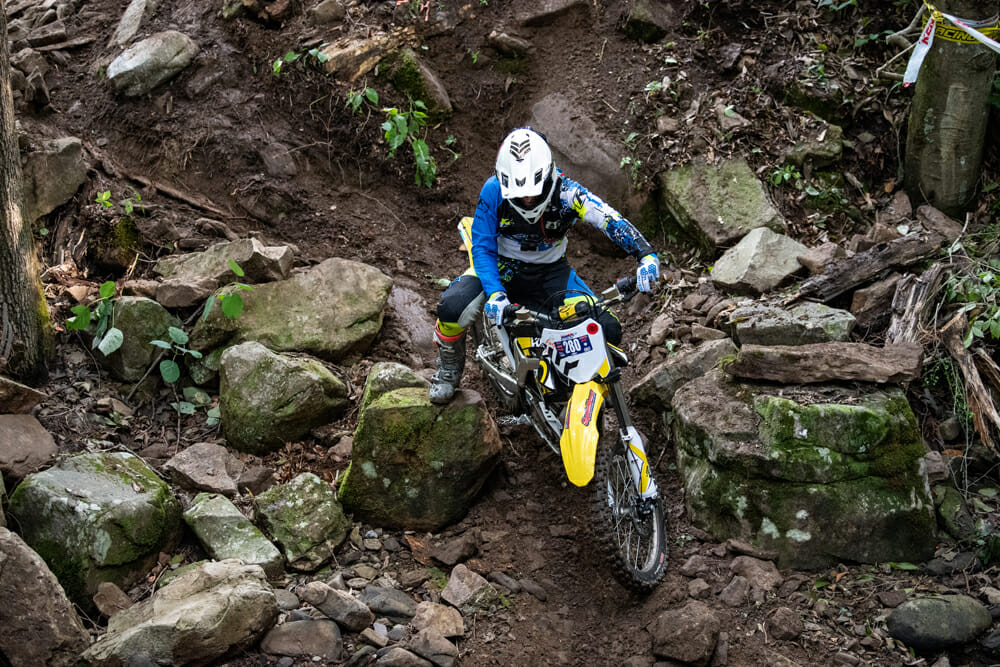
2023 Surron Storm Bee F Review | The Bottom Line
The TKO experience on the Storm Bee F was great. Hard enduro is a silly way to introduce or test a new motorcycle. It’s almost impossible to do well at the race, after all, so that could reflect on the machine. But I think it’s clear where most of the limitations are coming from here.
The bike could weigh 500 pounds and there are riders that would beat me on it. The point is this bike survived. Which isn’t easy. And that’s the point of hard enduro. Would it have been easier if I was on the 300cc two-stroke I’m familiar with? Maybe. But it still would have been super hard.
The only big letdown the entire day was our miss on the battery charging or dropping in a fully charged battery (which takes about five minutes) before the ECR EMoto main event. That would have saved me a couple finishing positions as I restarted the bike a few times. Big deal, right?
I predict in the next few years we will see more races open their doors to electric motorcycles, specifically. Maybe alongside gas bikes, but in their own class, like at TKO, and certainly open only to electric bikes in more urban areas where their benefits are obvious. And even though the Storm Bee F isn’t marketed as a hyper competitive machine. I think it will hold its own in the next few years. CN
Check out Episode 5 of 2022 TKO Hard Enduro: SUPERHARD!
VIDEO | 2022 TKO Hard Enduro: SUPERHARD!
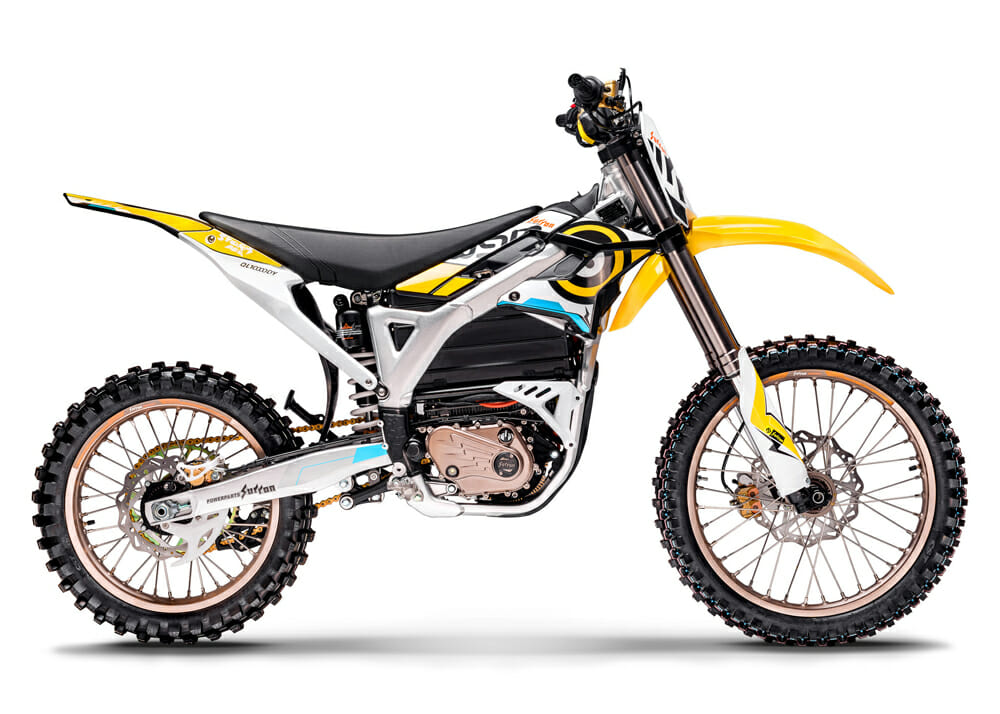
2023 Surron Storm Bee F Specifications
| MSRP: |
$8499 |
| Motor Type: |
Brushless electric (BLDC) motor |
| Cooling System: |
Liquid |
| Rated Voltage: |
104V (DC) |
| Rated Power/Peak Power: |
10,000W/22,500W |
| Controller Type: |
FOC Sine Wave |
| Peak Torque: |
520 Nm (383 ft-lbs) |
| Top Speed: |
110 km/h (68 mph) |
| Max Range: |
75 miles at 31 mph (120 km at 50 km/h), depending upon terrain |
| Battery: |
104V/55Ah Lithium Ion |
| Charger: |
10A |
| Charging Time: |
4 Hours (0-100%) |
| Riding Modes: |
Sport, Rain, Eco, Turbo |
| Rider Aids: |
ASR (Acceleration Slip Reduction, a.k.a. traction control), BERS (Brake Energy Regenerative System) |
| Reverse Gear: |
Button-activated |
| Drive: |
530 O-ring Chain |
| Front Suspension: |
47mm inverted fork, 290mm travel, adjustable compression & rebound |
| Rear Suspension: |
Fully adjustable monoshock, 290mm wheel travel |
| Front Wheel: |
21 in., wire-spoked rim, 80/100-21 off-road tire |
| Rear Wheel |
18 in., wire-spoked rim, 100/90-18 off-road tire |
| Curb Weight |
280 lbs. (127 kg) |
| Max Load |
220 lbs. (100 kg) |
| Minimum Ground Clearance: |
12.2 in. (310mm) |
| Wheelbase |
56.3 in. (1430mm) |
| Seat Height |
37 in. (940mm) |
| USB Connection: |
Single USB-2.1A Outlet |
| Instrumentation: |
LCD Digital Dash |
| Headlight: |
LED |
